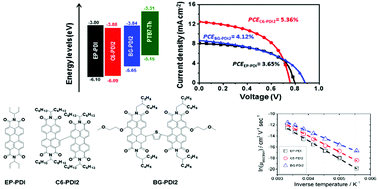Excimer formation effects and trap-assisted charge recombination loss channels in organic solar cells of perylene diimide dimer acceptors†
Abstract
Gaining deep insight into the operative mechanism of organic photovoltaic (OPV) devices made of perylene-diimide (PDI) electron acceptors is challenging. Herein we perform a comparative study of three different solution-processable PDI-based heterojunctions for identifying the parameters limiting their OPV device performance. In all three systems the PTB7-Th polymer serves as the electron donor mixed with one of the three derivatives of the EP-PDI monomer, and the C6-PDI2 and BG-PDI2 dimers. The obtained power conversion efficiency (PCE) of these PTB7-Th:PDI systems is PCEEP-PDI = 3.65%, PCEC6-PDI2 = 5.36%, and PCEBG-PDI2 = 4.12%. Despite the existing major differences in the molecular structure of the PDI acceptors the electron transport properties of all three PTB7-Th:PDI layers remain in the same order of ∼10−6 cm2 V−1 s−1. The electron mobility is found to have an activation energy close to ∼10kT thereby reflecting a high content of physical disorder in the three PDI acceptors. The endemic characteristic of trap-limited charge transport in PDI-based OPV layers is verified by (i) the dependence of open-circuit voltage on light intensity and (ii) the transient photovoltage characterization of the PTB7-Th:PDI devices. Based on GIWAXS measurements, the size of the well-ordered electron transporting domains in the OPV layers is between 4.0 and 6.8 nm, yet no evidence for PDI nanograin morphology features of the PDI multiadducts is found by scanning electron microscopy imaging. Photoluminescence spectroscopy reveals that all three PDI derivatives form emissive excimer-like states in the solid state, albeit with a different excimer stabilization energy. The losses induced by charge trapping are found to be increased in PTB7-Th:BG-PDI2, that is the derivative exhibiting the most stabilized excimer state and the smallest domain size. The optimum device efficiency of the C6-PDI2 heterojunction is attributed to its capability to form medium-sized electron transporting domains that are less disconnected by traps of disordered C6-PDI2 dimers. These findings signify the importance for PDI-dimer electron acceptors to maintain a three-dimensional configuration when used in OPV layers.



 Please wait while we load your content...
Please wait while we load your content...